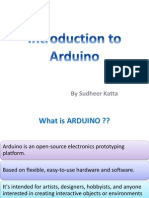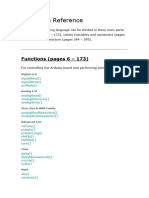0 ratings0% found this document useful (0 votes)
4 viewsProgramming-Arduino (1) - Pages-41
Uploaded by
axl1994Copyright
© © All Rights Reserved
Available Formats
Download as PDF, TXT or read online on Scribd
0 ratings0% found this document useful (0 votes)
4 viewsProgramming-Arduino (1) - Pages-41
Uploaded by
axl1994Copyright
© © All Rights Reserved
Available Formats
Download as PDF, TXT or read online on Scribd
You are on page 1/ 1
These three lines would each do something.
The first line would set the output of
pin 13 to HIGH. This is the pin with an LED built in to the Arduino board, so at
this point the LED would light. The second line would simply wait for 500
milliseconds (half a second) and then the third line would turn the LED back off
again. So these three lines would achieve the goal of making the LED blink
once.
You have already seen a bewildering array of punctuation used in strange
ways and words that don’t have spaces between them. A frustration of many new
programmers is, “I know what I want to do, I just don’t know what I need to
write!” Fear not, all will be explained.
First of all, let’s deal with the punctuation and the way the words are formed.
These are both part of what is termed the syntax of the language. Most languages
require you to be extremely precise about syntax, and one of the main rules is
that names for things have to be a single word. That is, they cannot include
spaces. So, digitalWrite is the name for something. It’s the name of a built-in
function (you’ll learn more about functions later) that will do the job of setting
an output pin on the Arduino board. Not only do you have to avoid spaces in
names, but also names are case sensitive. So you must write digitalWrite , not
DigitalWrite or Digitalwrite.
The function digitalWrite needs to know which pin to set and whether to set
that pin HIGH or LOW. These two pieces of information are called arguments ,
which are said to be passed to a function when it is called . The parameters for a
function must be enclosed in parentheses and separated by commas.
The convention is to place the opening parenthesis immediately after the last
letter of the function’s name and to put a space after the comma before the next
parameter. However, you can sprinkle space characters within the parentheses if
you want.
If the function only has one argument, then there is no need for a comma.
Notice how each line ends with a semicolon. It would be more logical if they
were periods, because the semicolon marks the end of one command, a bit like
the end of a sentence.
In the next section, you will find out a bit more about what happens when
you press the Upload button on the Arduino integrated development
environment (IDE). Then you will be able to start trying out a few examples.
You might also like
- Intro To Coding With Arduino: Sunday, February 12, 2012100% (1)Intro To Coding With Arduino: Sunday, February 12, 201211 pages
- Arduino Programming For ESD: by MD - Dedarul Hasan100% (1)Arduino Programming For ESD: by MD - Dedarul Hasan38 pages
- Worksheet 3 Quarter 3 Robotics and ElectronicsNo ratings yetWorksheet 3 Quarter 3 Robotics and Electronics7 pages
- GR 7 Robotics - Lesson 6 - Intro To Arduino and BlinkNo ratings yetGR 7 Robotics - Lesson 6 - Intro To Arduino and Blink21 pages
- Arduino Workshop Handouts: Basics of Programming and Electronics Reference SheetsNo ratings yetArduino Workshop Handouts: Basics of Programming and Electronics Reference Sheets6 pages
- ECE 513 Part1 ArduinoUnoFundamentals Ver1.2No ratings yetECE 513 Part1 ArduinoUnoFundamentals Ver1.276 pages
- Lecture 04 05 IoT Systems Logical Design Using Arduino Part 1 2No ratings yetLecture 04 05 IoT Systems Logical Design Using Arduino Part 1 266 pages
- Arduino C Language Reference - Eidan YosonNo ratings yetArduino C Language Reference - Eidan Yoson295 pages
- Master Builder Power Up! Level 2: Minecraft® Redstone for Intermediate PlayersFrom EverandMaster Builder Power Up! Level 2: Minecraft® Redstone for Intermediate Players3/5 (4)

































































